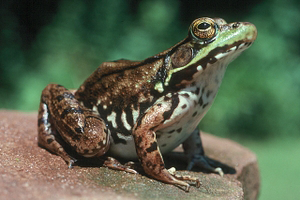When approached along the edge of a pond, green frogs often give a loud squeak call and leap into the water. They usually return to shore soon and may allow you to get a close look at them if you move slowly.
Photo Credit: Geoffrey A. Hammerson
Lithobates clamitans
Common Name: green frog
Other Common Names: bronze frog
Other Scientific Names: Rana clamitans
Animal Guild: Amphibian
Class > Order > Family: Amphibia > Anura > Ranidae
What does the species look like?
Adults: Green frogs are green, greenish-brown, brown, or bronze (nearly black when cold), and often have numerous dark spots or blotches. They have a straight ridge that extends along each side of the back—it begins behind the eye and ends on the back. The hind legs are crossbanded, which you can see when the legs are folded. The webbing on the hind toes does not reach the tip of the fifth toe and barely extends past the second joint of the fifth toe. Green frogs generally reach a maximum size of around 4.3 inches (10.8 cm) snout-to-vent length.
Mature males: In adult males, the eardrum is much larger than the eye, and the throat may be yellow.
Mature females and juveniles: In adult females and juveniles, the eardrum is about the same size as the eye. Breeding call: The breeding call is a single croak or series of croaks; each croak sounds like a loose banjo string being plucked. Larvae: The elongate larvae are olive green with irregular dark marks (not sharply defined black spots) on the body; the tail is usually heavily dark mottled. The papillae around the mouth are large, somewhat flattened, and heavily pigmented. Larvae may grow as large as 4 inches (10 cm) long. Eggs: Females lay eggs in masses of up to several thousand eggs. The eggs initially float at the water surface or are partially tangled in vegetation. Later, the eggs sink.
Where is the species found?
States & Provinces
AL, AR, BC, CT, DC, DE, FL, GA, IA, IL, IN, KS, KY, LA, MA, MB, MD, ME, MI, MN, MO, MS, NB, NC, NH, NJ, NL, NS, NY, OH, OK, ON, PA, PE, QC, RI, SC, TN, TX, UT, VA, VT, WA, WI, WV
Distribution
The green frog’s range extends throughout the eastern United States and adjacent southeastern Canada. This species has been introduced in Newfoundland, British Columbia, Washington, Utah, and probably elsewhere.
Green frogs inhabit virtually any body of permanent or semipermanent water, as well as vernal pools; juveniles regularly use nearby, small, temporary pools and puddles. Individuals may travel relatively far from water in wet weather, especially at night. They typically breed in shallow, slow-flowing, or stagnant water.
General Phenology and Life History
Green frogs are inactive during cold weather in winter, when they find shelter under objects on land, underground, or in water. Many spend winter in the flowing water of small streams. Their wintering sites may be in the same areas where they breed or several hundred meters (or yards) away.
These frogs typically breed in spring or summer. In the north, males call mainly in late spring and early summer (mostly May to August). In the south, breeding may occur as early as March. Adult females deposit one to two clutches of as many as several thousand eggs. Larvae emerge in three to seven days. In the south, larvae from early clutches may metamorphose in a few months. Larvae from late clutches overwinter before metamorphosing, as do most larvae in the northern part of the range.
Which phenophases should I observe?
Do you see/hear...?
Activity
Adults on land More...
For abundance, enter the number of individual animals observed in this phenophase.
Adults in water More...
For abundance, enter the number of individual animals observed in this phenophase.
Adults feeding For abundance, enter the number of individual animals observed in this phenophase.
Reproduction
Vocalizing What is the intensity of vocalizing?
Single calls: There is space between calls and individuals can be counted. Overlapping calls: Calls of individuals can be distinguished but there is some overlapping of calls. Full chorus: Calls are constant and overlapping.
Mating For abundance, enter the number of individual animals observed in this phenophase.
Fresh eggs For abundance, enter the number of individual animals observed in this phenophase.
Development
Dead adults For abundance, enter the number of individual animals observed in this phenophase.
What do these phenophases look like?
There is currently no photoguide available for this species. If you'd like help us create one, use the guidance document and species template provided here . Then send it via email to education@usanpn.org when it is complete.
